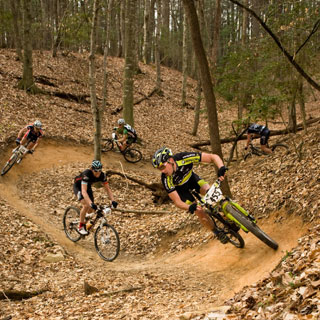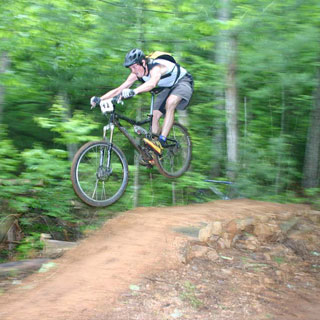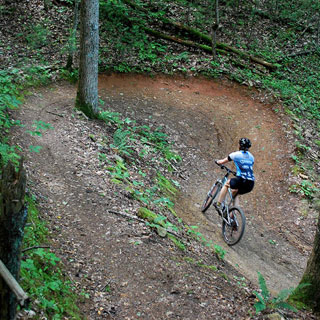Mountain Biking
Some of the best mountain biking in the southeast can be found along the scenic shores of W. Kerr Scott Reservoir near Wilkesboro. The lake is home to over 35 miles of sweet singletrack, with more under construction.
Ride any of Kerr Scott’s trails and it won’t take you long to figure out what they’re known for – bermed turns. There are three main trail networks: Dark Mountain, Overmountain Victory Trail (or OVT), and Warrior Creek. Most riders park at any of the main trailheads for the shorter rides, or set up a shuttle to incorporate more trails.
The Trails at Kerr Scott
The trails at Kerr Scott were built by mountain bikers for mountain bikers. They’re fast, fun and ready to ride!
Dark Mountain is a series of trails laced into both sides of a rugged wooded ridge. Loop after loop of singletrack rolls through a mature hardwood forest. The trails at Dark Mountain are steep, tight and fast with good flow and lots of variety. Three wooden decks atop the ridge offer wide views of the lake and the surrounding mountains.
Overmountain Victory Trail (or OVT) offers the most flowing trails at Kerr Scott. Every turn is bermed and the climbs are relatively friendly. OVT flows past views of the lake, dips deep into the woods through a quiet stream on a rock crossing and traverses steep hillsides with mature hardwoods and boulder outcroppings.

The Warrior Creek Loop completely encircles its namesake campground, following the folds of the lake. This loop is the newest of the trails at Kerr Scott. Expect loads of memorable berms and several rock gardens. The Headwaters loop features the most technical challenges of the entire trail system.
 The Kerr Scott trails are an official IMBA EPIC Trail System
The Kerr Scott trails are an official IMBA EPIC Trail System
All three trail systems have their own character, and riding the Epic route will take you to the best of each. Combine all three trails for the Official EPIC experience:
Trail Building
Want to help build and improve the trails Kerr Scott? We have multiple trail days throughout the year. Trail days will be listed on this site in the Events section and on the BMCC and accounts.
Information
The Kerr Scott Visitor Information Center is the place for info. Here, you’ll find trail maps, camping and day-use information, and more. Public restrooms are available during the season.
Hours: 8am – 4:30pm
Phone: .
There is free parking at all trail locations, but fees may apply at the Warrior Creek Trail entrance lot since it is considered a “day use” area. Free Parking for Warrior Creek is available at the back parking lot off of Boomer-Ferguson Road. Campgrounds at Kerr Scott are right next to trail crossings, so route planning can can include “ride-in/ride-out” options.
Trail Closings
The trails close occasionally for bad weather. If the forecast looks sketchy, check for trail closings through the
Directions
Coming in from out of town? Find your driving directions here.
Rules of the Trail
- Leave no trace. Stay on existing trails…don’t create new ones. Don’t cut switchbacks. When the trailbed is muddy, consider other riding options. Be sure to pack out at least as much as you pack in.
- Always yield the trail. Let your fellow trail users know you’re coming. Anticipate other trail users around corners or in blind spots. Slow down, establish communication and be prepared to stop if necessary. Trails are used by hikers, trail runners and dogs as well as fellow cyclists.
- Ride safely. Know your equipment, your ability, and the area in which you’re riding — and prepare accordingly. Always wear a helmet and appropriate safety gear.
- Don’t modify or relocate stunts. This can endanger other riders. All trail changes must be approved by the U.S. Army Corps of Engineers.
- Don’t get locked in. If you’re riding at Dark Mountain, note what time the dam will close before you park. If you’ll be riding after hours, park at the visitor assistance center or in the small lot near the dam gate and ride across the dam and down the hill to the trailhead. The road across W. Kerr Scott Dam closes at 4 p.m. through the winter. After 4:00, the gate will be locked.
- Bring plenty to drink. There are no facilities on the trails. Water and flush toilets are located in the W. Kerr Scott Visitor Assistance Center and at Bandits Roost Campground. Mens and ladies latrines are located in the Fish Dam Creek Overlook picnic area near the circle.
- Call if you need help. If you need assistance from a ranger, call . If you need immediate medical attention, call 911.
- Report unsafe trail conditions. If any area of the trail needs attention, please contact BMCC’s trail crew via .
- Follow park rules. Park only in designated parking areas. Camp only in designated campgrounds. No alcoholic beverages. No fires except in designated areas. No hunting. No littering.
Blazing The trail at Kerr Scott
Members of the Brushy Mountain Cyclists Club built the trail network, assisted by community volunteers including local Boy Scouts. The project ranks as one of the biggest volunteer projects in community history, with well over 6,000 hours logged.
The Brushy Mountain Cyclists Club (BMCC) builds and maintains all of the trails at Kerr Scott. The BMCC’s relationship with the US Army Corps of Engineers is an amazing model of partnership. The MOU (established in 2002) was the first of its kind in the country between a club and USACE.
BMCC has built nearly 40 miles of trail at Kerr Scott since 2002. It all got started in that year with Dark Mountain, and was orchestrated by a visit from IMBA Trail Care Crew. Under the leadership and zeal of BMCC Trail Boss, Jim Horton, and thousands of volunteer hours, trail mileage continues to grow. Also growing is its significance as national destination for mountain biking.
The trails hold three national designations: Dark Mountain was named a National Recreation Trail in 2005, The OVT has been a part of the Overmountain Victory National Historic Trail System since its completion in 2006, and the entire Kerr Scott Trails system was named an IMBA Epic in 2011.
BMCC-led trail crews continue to build new trails and maintain existing trails at Kerr Scott. Want to help? Help us build some trail!
About Kerr Scott Reservoir
 W. Kerr Scott Reservoir is a beautiful lake set in the foothills of Northwest North Carolina. Recreation areas ring the 55-mile shoreline of the lake. Popular activities include boating, fishing, hiking, mountain biking, camping and picnicking. Facilities at Kerr Scott include three campgrounds, four designated swimming areas, a marina, and a visitor center with a museum and bookstore.
W. Kerr Scott Reservoir is a beautiful lake set in the foothills of Northwest North Carolina. Recreation areas ring the 55-mile shoreline of the lake. Popular activities include boating, fishing, hiking, mountain biking, camping and picnicking. Facilities at Kerr Scott include three campgrounds, four designated swimming areas, a marina, and a visitor center with a museum and bookstore.
The lake is nestled amid 3,754 acres of land in the Blue Ridge foothills. The forested hillsides above the reservoir are home to a wide variety of wildlife and several varieties of endangered plants.
The 1,475 acre reservoir was built by the U.S. Army Corps of Engineers in 1962 in response to devastating floods in 1916 and 1940.


